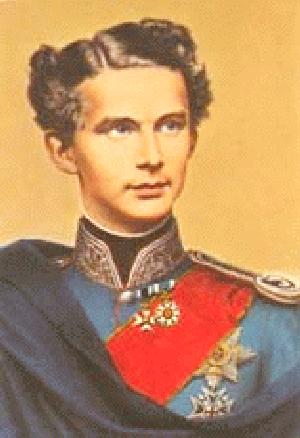
Figure 1.--The young Ludwig II is shown here in the military uniforms he loved.


Figure 1.--The young Ludwig II is shown here in the military uniforms he loved. |
The Bavarian royal line is best known for Mad King Ludwig who built his fairy-tale castle in the Bavarian mountains during the 19th Century. Oddly enough, the romantic, whimsical castles built by King Ludwig II are today the country's most recognizable attraction. Ludwig was eventually declared insane and removed from office. His brother, Otto, also being insane, Prince Luitpold acted as regent. The princes were no doubt affected by a terribly repressive childhood at the hands of their strict father and his strange ideas about child rearing.
Ludwig was officially born August 25, 1845. is his official date of birth. He was actually born an hour earlier, on Sunday 24 August at 11.30 pm. The birth was kept secret for an hour. The reason for
this was that Ludwig’s grandfather, the reigning King Ludwig I, was also in Nymphenburg Castle at the time of the birth. It was his dearest wish that the child should be born on his own birthday, August 25.
As Prince Ludwig arrived an hour early, they decided to wait an hour before announcing the birth, to
fulfill his grandfather’s wish.
Maximilian who showed little interest in his son as a boy, was quite overcome, when his son was born. He wrote to his brother-in-law, Prince Adalbert of Prussia: "It is a magnificent feeling to
be a father." The next day, August 26, 1845. Prince Ludwig was formally baptized by Archbishop Gebsattel in the Great Hall of the
castle.In the presence of numerous relatives, the prince’s eventeen-year-old Uncle Adalbert, Maximilian’s youngest brother, held the baptismal candle. The grandfather, Ludwig I held the child.
The godparents were Ludwig’s great uncle, King Friedrich Wilhelm IV of Prussia and his uncle, King Otto of Greece (who, however, was not present at the christening).
A few days later grandfather, King Ludwig I intervened and asked for his grandson’s name to be changed to Ludwig because he was born on "Ludwig’s Day", that is, the king’s birthday. The boy’s parents decided, despite the baptism to the contrary, to accede to his grandfather’s wish and gave the young prince, who had now been called Otto for some days, the Christian name Ludwig, and he was known as Ludwig from then onwards. His full name was Prince Ludwig Friedrich Wilhelm von Wittelsbach. For his part the prince’s namesake, King Ludwig I, had been named after his godfather King Louis XVI of France. Thanks to his grandfather, the house of Wittelsbach had very close ties with the French kings, a fact which played a major part in the life of Ludwig II.
Ludwig's Granfarher was delighted with the young prince. Three years after Ludwig's birth, Ludwig I abdicated. This was not because of his affair with Lola Montez as has often been claimed but as a result of the revolution of 1848. Liberal revolutions swept Europe in 1848. Many conservative monarchies managed to supress the demands for democratic rule. The revolutionaries forced the Bavarian Crown to make more concessions to the elected parliament. Ludwig I could not accept this. His vision of a kingdom ordained by God could no longer be reconciled with the increasing powerlessness of the throne. If he could no longer rule, he no longer wanted to be king. His grandson Ludwig II was later to see things in the same way but with the opposite result: he wanted even more to be king, because he could no longer rule. In any case Ludwig I gave up the throne to his son, Maximilian, on March 20, 1848.
Ludwig’s father, Maximilian II, became king of Bavaria at the age of 37. From then on the 2 1/2-year-old Ludwig saw very little of his father, as indeed had already been the case for some time. His father may not be one of the worst royal fathers, but he indeeds seems to have been a very poor one.
Ludwig's mother was Princess Marie Hedwig of Prussia (1825- ). She ws the youngest daughter of King Frederick William II of Prussia (1744- ) and Frederica Louise of Hesse-Darmstadt (1751- ). The Princess married Married Maximillian October 10, 1842.
Ludwig was now crown prince. As a baby he was not suckled by his mother, but, as was the rule in European royal families of the time, by his wet-nurse. Over the years there were many rumours about this nurse; for example, she was said to have had syphilis and, through breast-feeding, to have infected the young Prince Ludwig. However, these rumours seem all to have been unsubstantiated and groundless.
There is only a basis for such rumours, if one accepts that King Ludwig became mentally ill. But there is no longer any real reason to believe this. Ludwig’s mother not only denied the child her breast but also the heartfelt love that is so important for an infant. From
a very early age Ludwig suffered from his mother’s coldness and lack of love. Later he was to describe his royal mother, with whom he always behaved very correctly, as a selfish, opportunistic, materialistic and pleasure-seeking woman, whom he did his best to avoid as much as possible. He always kept himself well informed of his mother’s whereabouts, so that he could arrange not to meet her.
Ludwig came to have little regard for his mother. As a young man, he did not even acknowledge her conversion from the protestant to the Roman Catholic faith, which she underwent in the church at Waltenhofen. He saw it only as a sign of her inconstancy and opportunism, which led her to adopt the religion of the majority in catholic Bavaria. His relationship with his mother remained a serious problem throughout his life and caused in him a strong mistrust of all things female, despite the fact that these were precisely what he yearned for.
Evidence of her own lovelessness was her aversion to the very word "love". At a symposium organised by Maximilian II in his study at the royal residence, at which the intellectuals of Munich showed off their learning and exchanged profound thoughts over beer and cigars, Queen Marie (who seems to have been there by accident) made the proposal that in future the word "love" should be replaced by "friendship" in all poetry.
This spiritually barren mother is described thus by Paul Heyse: "Despite tremendous efforts, it has
proved impossible to interest the queen in literature and poetry. She is only happy with the most trivial chatter" To one woman Marie said quite frankly: "I never read a book and cannot understand how anyone can just sit down and read." When Ludwig was 6 years old, Queen Marie wrote the following lines about her son in her diary: "From an early age Ludwig has been fascinated by art; he loves building, especially churches, monasteries and the like."
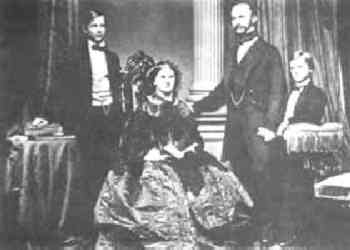
Figure 2.--The family is pictured here about 186? |
Prince Ludwig's wet-nurse died of typhoid fever when he was only 8 months old. Ludwig had to be suddenly weaned, became ill, and there was great anxiety about his life. Ludwig became Crown Prince of Bavaria at the age of 3. His grandfather was forced to abdicate as a result of his liaison with the scandalous Lola Montez. Ludwig was manoeuvred into a position of prominence,
restrictions, extreme isolation and loneliness. Servants now had to bow in reverence to the young Prince who was styled "Royal Highness".
Leopold as a child had a touchy pride in his high position; he had to come first, whether it was in games
with younger brother Otto (1848-1916) or the order of precedence when entering a room in company. Once he stole a purse from a shop and when he was reprimanded by his governess, Sibylle Mailhaus, Ludwig maintained that, as a future king of Bavaria, "everything in Bavaria belonged to him". Later, Ludwig's pet tortoise was taken from him because it was thought that he was becoming too attached to it. At the age of 6, Ludwig already loved building with toy bricks, while his brother Otto drilled his tin soldiers. Ludwig never let Otto forget that he was the Crown Prince and on one occasion Ludwig tied his
younger brother up and threatened to behead him, a fate from which Otto was
saved by the timely arrival of a Court official.
Ludwig’s interest in religion and spirituality also emerged in his early years. Queen Marie noted in her
diary that Ludwig enjoyed listening to her reading him Bible stories and showing him pictures of them.
The young Ludwig was particularly enthusiastic about dressing up as a nun and playing at life in a
convent! Above all he started acting from a very early age, his natural inclination towards this being
developed by the fact that his mother put her heart and soul into reading Hans Andersen’s fairy tales
to the children, and at Hohenschwangau she acted out the stories with the children.
There were even times when a considerable number of local people took part in these fairy-tale plays, if
the story demanded a large cast of characters or "extras". Prince Ludwig was quite entranced by these
performances. Other children were often invited to Hohenschwangau Castle to entertain the princes.
These children were allowed to treat the princes as their equals and to talk to them quite naturally as
they would to any other child. Problems only arose when the young Count Tony Arco was caught giving Ludwig a clip round the ear. That was too much for the family, and from then on the children’s activities were much more tightly controlled.
The young Max Schramm lived with his parents in a house which is now number 25 Alpseestrasse. The
princes and Max Schramm used to visit each other and play together, either in Hohenschwangau Castle
or At the Schramms’ house, or they were also allowed to play in the idyllic countryside around the
castle. The relationship between Ludwig and Otto and their young playmate, Max Schramm, was not affected by the Arco incident (Max was the eldest son of the Hohenschwangau castle warden and his wife, Franz and Anna Schramm). Their favorite game was for Ludwig to be the king, with Otto and Max playing his subjects and servants.
It is well known that Maximilian II was captivated by the ancient Greek ideal of a strict upbringing and was especially influenced by the Stoics. So, for example, the king instructed that his two sons, Ludwig
and Otto, should never be allowed to eat until their hunger was fully satisfied. He was worried that his sons might grow up as weaklings or fall prey to decadence. Both princes suffered considerably under this régime and as a result of it were always hungry. Both the housekeeper, Liesl, and the footmen frequently let the princes have a share of their own generous rations. In spite of this, it is still not surprising to learn that the princes took every opportunity to escape from narrow confines of the castle.
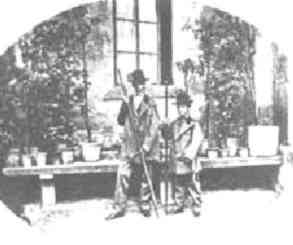
Figure 3.--The princes are shown here traditional clothes. Note that they are wearing long trousers. |
In the Schramm household the princes were always offered something to eat, even though the
Schramms knew perfectly well that this did not accord with the wishes of the royal parents. But it was
not only at the Schramms that the princes tried to satisfy their hunger. They also called on other
families in Hohenschwangau. And in the fields and meadows Ludwig and his brother sought out the
company of Schwangau farm laborers, who tended not to go home for the midday meal but took a
simple packed lunch into the fields, which they were happy to share with the two royal youngsters. It
soon became well known in the local farming community that the princes were always hungry and that
this was caused by the king’s eccentric views on the upbringing of children.
Prince Ludwig also frequently accompanied the castle warden, Franz Schramm, on his daily rounds. This was because Ludwig, with his constant thirst for knowledge, never tired of the many stories that
Franz Schramm told. Over the years Schramm had become an unrivalled expert on Hohenschwangau
castle, its history and legends. He told the princes all the mysterious stories about the castle and the
knights of Schwangau as well as a wealth of German folk tales. And Crown Prince Ludwig maintained
his contact with castle warden Schramm even after he was crowned king of Bavaria. This fatherly friend
became warden of Hohenschwangau when Ludwig was only 4 years old and held the post until 4 years after the king’s death in 1886.
From his earliest childhood Ludwig discovered that it gave him great pleasure to give his possessions
and money away to others. Apart from that Ludwig was a difficult child, which was hardly surprising in
view of his unusual upbringing. He and his brother were both extremely shy and withdrawn. In spite of
this the sensitive young Ludwig was generally liked by his fellow men. His father, Maximilian II, was
relentlessly strict with his upbringing. It was not only at meal-times that the children experienced this.
Youthful pranks and neglect of duty were punished with unrelenting severity. If a tutor reported unfavorably on Ludwig he was charged with administering the required caning.
The memory of his harsh upbringing and his frosty relationship with his father dogged Ludwig throughout his life. Fully 20 years later he still spoke bitterly about this period of his life. The Cabinet Secretary, Franz von Pfistermeister, recorded that Maximilian rarely allowed himself to be persuaded to
take his son Ludwig with him on his morning walk in the English Gardens. "What would I have to say
to this young gentleman? He is not interested in the things that interest me," he said to Pfistermeister.
There can be little doubt that in fact it was the other way round: the father was not interested in
anything that interested his son. Myths and legends were the only things for which father and son
shared a common enthusiasm.
Maximilian’s inflexible ideas on the upbringing of
children extended well beyond the subject of food.
He insisted that his sons were always woken very
early, so that they rarely had enough sleep. He took
every step imaginable to prevent his sons, especially Ludwig the dreamer, being pampered. For example, Ludwig had a tortoise which he was very fond of and which he looked after diligently. When his father found out about this he immediately had the tortoise taken away.
The boys were given only meagre amounts of pocket money. One day, in order to get hold of some money, Prince Otto went of his own accord to a Munich dentist and tried to persuade him to take out two of his back teeth, because he had heard that healthy teeth fetched a good price. Ludwig kept accurate accounts of his money in an exercise book. This shows that he gave away the majority of his limited pocket money or spent it on other people.
There is limited information available on the clothes the two princes wore. As little boys they wore dresses. Available images show rather plain dresses. As older boys the princes were often dressed alike as was the fashion in many royal families. The boys also wear traditional alpine dress. Interestingly they always wear long pants, not even the knicker style of lederhosen.
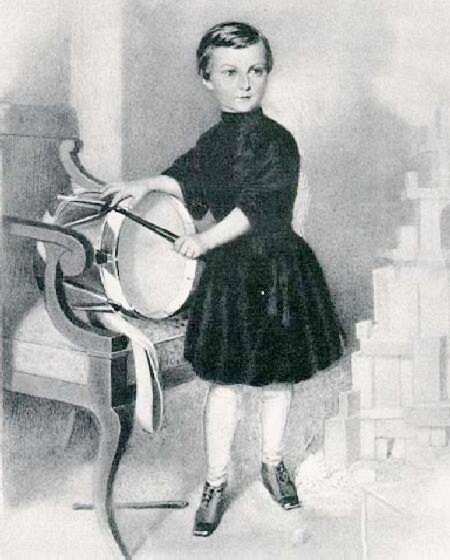
Figure 4.--One image shows Prince Ludwig wearing a plain dark dress with no colar or wrist trim in 1850. He was 4 years old. He is playing with his drums. Notice the blocks in the bakground. |
Both Prince Ludwig and Prince Otto wore dresses as younger boys. One image shows them wear similar, but not identical plain frocks. They my have also had some identical dresses. Availble images show them wear very plain colored dresses with only modest or no trim. I am not sure what the colors were. They may have had fancier dresses, but I can not confrm this. One image shows Prince Ludwig wearing a plain dark dress with no collar or wrist trim. Ludwig and his brother wore their dresses with both long stockings and three-quarter socks. One image shows Prince Ludig wearing his dresses with bloomer knicker. We know that Prince Ludwig was wearing dresses in 1850 at age 4. We do not know how long he wore dresses after 1850 or when he was breeched.
The boys in many available photographs show them wearing adult-looking suits. Ludwig in these pictures , some of which are dated, look to be look to be about 13 or so. His brother looks to be about 8 or nine.
The boys also wear traditional alpine dress. Interestingly they always wear long pants, not even the knicker style of lederhosen.
Prince Ludwig and his brother seemed to have worn relatively short hair styles. Even when wearing dreeses at ages 2-4 years the boys had short hair. They never had severely shot hair. They never appear to have had long curls.
His difficult relationship with his mother, referred to earlier, was made worse by the fact that his younger brother, Otto, was very much her favorite. Prince Otto was born in 1848 and was anbour 2 /2 years yonger than Ludwig. So Ludwig, who yearned for his mother’s love, was often despondent about this. Sometimes he even hated his brother because of it. Ludwig Schaufert relates that on one occasion the crown prince took a snowball away from his brother because it was bigger than his own. When his tutor told him to give it back, he burst out: "Why shouldn’t I have this snowball? I’m the crown prince!" Ludwig never let his brother forget that he was the heir to the throne. This was the only way he knew of coping with his mother’s neglect of him.
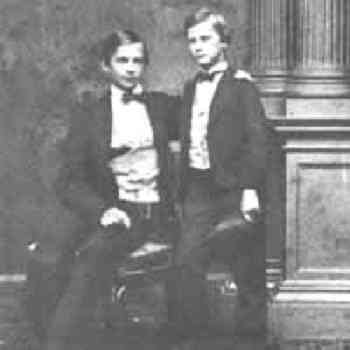
Figure 5.--Ludwig and Otto are shown here in 1860. |
Conflict between the two brothers might take on a quite dramatic form. On one occasion Ludwig tied up his younger brother and threatened to decapitate him! Only the intervention of a servant rescued Otto from this situation. One biographer, however, claims that "In spite of such incidents the brothers generally got on well together."
Ludwig’s relationship with his nurse was totally different from that with his parents. Luise von Kobell reports that this nurse absolutely adored the new-born infant. Once past the infant stage, Ludwig was given a governess who was known as "Bonne" and who came from France. In the nursery she always gave precedence to Ludwig. Ludwig’s later love of the French language is probably due to the influence of this French governess. It was from her that the boy learnt his first French words and gained his first knowledge of the French "Sun King", Louis XIV. She also taught him the Bourbon motto: "L’état c’est moi". The governess, Sibylle Meilhaus, was responsible for Ludwig until he was 9-years old. Ludwig was very fond of Fräulein Meilhaus, who later became Baroness von Leonrod, and kept in contact with her until she died in 1881.
At nine Ludwig was given a tutor, Major General Theodor de la Rosee. Wilfried Blunt described him as a thorough snob "who spent more time admonishing his pupils and ensuring that they kept a proper
distance from the lower orders than he did teaching them the contents of their schoolbooks". The dreamy child had considerable difficulty with learning. He learnt to speak French fluently, because he
was highly motivated and because the language suited his self image and outlook on life, but he did
not get far with Latin and found Ancient Greek even more difficult, although he did manage to absorb a
basic knowledge of the classics.
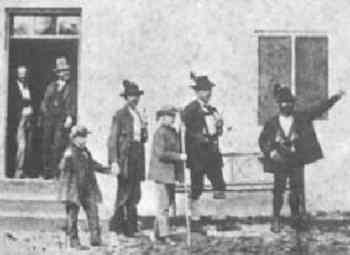
Figure 6.--The two princes, Ludwig and Otto are shown here preparing for a hiking tour in 1858. Ludwig would have been about 13. years old. Note that both Ludwig and Otto wear long pants. |
From an early age Ludwig got to know and love the mountains, especially those around Füssen. This positive aspect of his character was very nearly killed off by his mother’s own zeal for the mountains.
She forced the princes to go walking and climbing in the mountains with her, even when it was the last thing they felt like doing at the time. Marie brought a thoroughly competitive attitude to this activity and positively raced over the mountains. This did not suit Ludwig at all; he would much rather have made frequent stops to sit down and soak up the idyllic mountain atmosphere. That was not possible when out with his mother. Only when Marie’s growing weight brought a natural end to her mountain walking could CrownPrince Ludwig develop his own more spiritual, rather than sporting, relationship with the mountains.
Ludwig was passionate about opera. Before he was 13 years old, Ludwig learnt from his governess about the Munich production of Richard Wagner’s "Lohengrin". In the same year at his own request his tutor gave him Wagner’s book, "Opera and Drama" as a Christmas present. Soon Ludwig immersed himself in Wagner’s works. He read both "The Art of the Future" and "Future Music" written by the composer. At the age of fifteen in February 1861 Ludwig heard a Wagner opera for the first time. It was "Lohengrin". He was overcome by this experience. He pestered his father, Max, until he promised to arrange a second performance of "Lohengrin" for him. This eventually happened in June 1862, when he was 16 years old. Then, when a few months later he heard "Tannhäuser", he was beside himself with rapture. At the point where Tannhäuser returned to the Venusberg, Ludwig’s body began to twitch visibly, so that Leinfelder, who was sitting next to him in the box, feared he was having an epileptic fit. So began his love of Wagner.
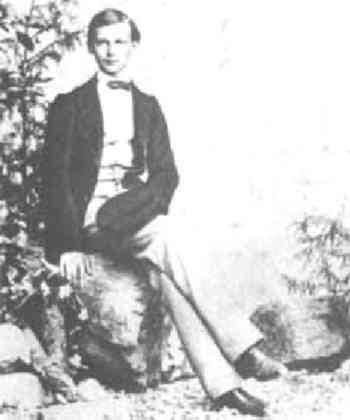
Figure 7.--Ludwig his shown here in a suit as a young man. He and his brother began wearing such suits when they were quite yioung. |
The increasingly eratic 21-year-old Ludwig in 1867 surprised nearly everyone in Bavaria, including his family, when he announced his enggement to Princess Sophie, the younger sister of his cousin and longtime friend Emperess Elisabeth, wife of Austrin Emperor Franz Joseph. The Empress, a cousin and life-long friend, knew the King well. She was critical of the officials that deposed him. "The king was not mad," she said, "he was just an eccentric living in a world of dreams." He was, however, during the engagement showing signs of mental instability. As so often in his adult lif, there were problems with his spending. He is reported to hav spent more than a million gulden in the construction of a lavish wedding coach. He then apparently had second thouhts and asked his doctor for a certificate declaring himself unfit to marry. He also apparently told an official that he would drown himself before going through with the marriage. He seems to have amused himself by sitting before a mirror making faces at himself and declaring: "At times, I would not swear that I am not mad." He postponed the wedding date several times until, in October, he finally canceled it.
King Ludwig I's eldest son acceded to the throne in 1864 upon the death of his father. Known as the "fairy tale king," Ludwig II built some of Bavaria's most-visited tourist attractions such as Neuschwanstein castle and Herrenchiemsee palace. Neuschwansteinis situated in the majestic mountains of the Allgau region of Bavaria. It is so beautiful that inspired Disney’s famous Cinderella castle. Schwan, a term common to both castles, literally means swan and was favored by Ludwig as a symbol of purity. The birds played an important role in Richard Wagner’s opera "Lohengrin" the operat that so enchanted Luwg as a teenager. Later, King Ludwig II, who developed a passion for art and music, developed a relationship with the composer/writer that helped to inspire d him to create his own imaginary world. His contruction projects ran up enormous debts and he had plans for even more building. The Government thought Ludwig was irresponsible and eccentric.
Bavaria had been a leader among the German states opposing unification. It was King Ludwig II, however, that after the Franco Prussian War (1870-71) invited King Wilhelm I of Prussia to become emperor (kaiser) of a new united German Empire. Ludwig was put under great pressure to do this. For Bismarck the protracted negotiations with Bavaria and the other German principalities drove him to distraction. [Ludwig, pp. 388-389.] Despite his Prussian ancestors, Ludwig disliked the Prussians and Prussian militarism. The German Empire ended Bavarian sovereignty. The liberal Bavarian kingdom was thus involved in the much more conservative Empire dominated by Prussia. Interesting though, it was Bavaria after World War I that proved to be one of the hot beds of NAZIism.
Culture flourished in Bavaria under Ludwig. Richard Wagner worked in Munich and many of his operas receive their world premieres in the city.
Ludwig was forced to abdicate the throne. This was of some concern to Chancellor Bismark as Bavaria was part of the German Empire. He drowned, along with his doctor, in Lake Starnberg. The circumstances of his death are not known. Many commentators assume that Prince Luitpold instigated the conspiracy to declare Ludwig and Otto insane. The view is that Prince Luitpold usurpered the Bavarian Crown. Others argue that nothing could be further from the truth. The Prince in fact waited and considered matters for nearly 3 months before accepting the advise of Prime Minister Lutz and the Cabinet to force Ludwig to abdicate.
After King Ludwig II died in 1886, his brother Otto succeeded him as Otto I. Prince Otto was born in 1848. He was the son younger son of King Maximilian II, of Bavaria and King Ludwig II's younger
brother. He acceeded to the throne in 1886 upon his brother's death. As he was also considered insane, Prince Luitpold (1886-1913), Ludwig's and Otto's great uncle, served
a regent. Prince Otto was considered to be demented. He was proclaimed King in 1886 in spite of his mental derangement.
Prince Otto showed serious signs of madness as early as 1875 and was soon afterwards was deprived of his freedom. His
uncle Prince Luitpold was appointed Regent. Perhaps out of family considerations, Prince Luitpold was never crowned and served as regent. King Otto was not replaced, however, until 1912. He died in 1916. Otto, like his brother Ludwig, never married.
We beliebe that there have been several dramitizations of Ling Ludwig's tragic life. We have few details at this time, but know of a British Blue Peter TV production.
Ludwig, Emil. Bismarck: The Story of a Fighter (Little Brown, Boston, 1927), 661p.
Navigate the Boys' Historical Clothing Web Site royal pages:
[Main German states page]
[Main Bavarian royal pages]
[Austria]
[Belgium]
[Denmark]
[France]
[German Empire]
[Italy]
[Luxenburg]
[Monaco]
[Netherlands]
[Norway]
[Romania]
[Russia]
[Spain]
[United Kingdom]
